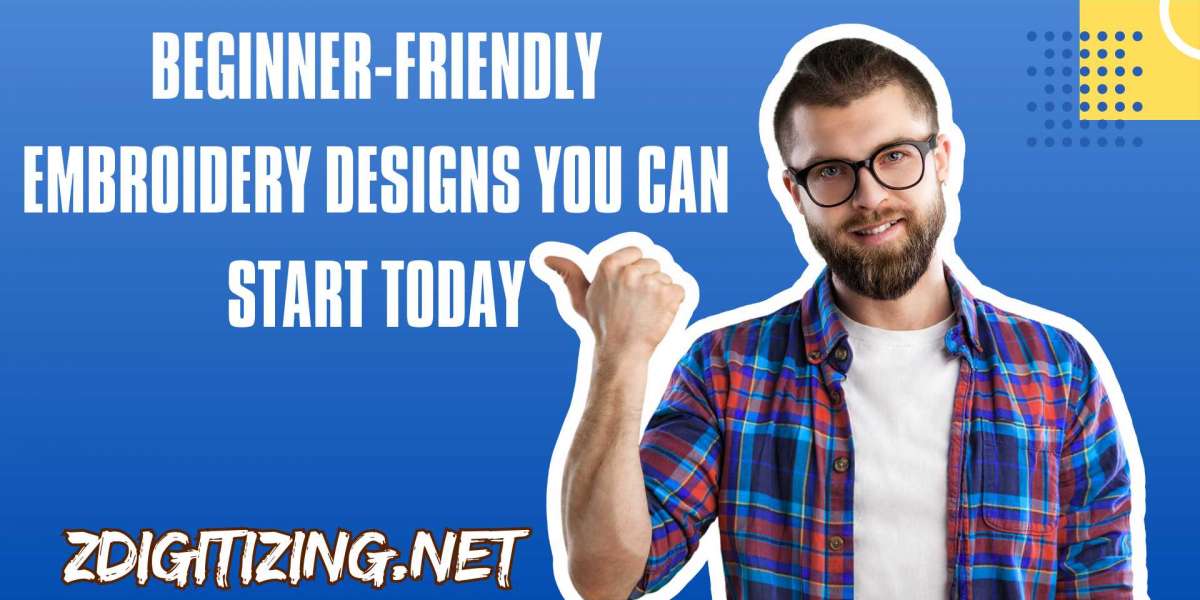Embroidery is one of the most relaxing and creative hobbies anyone can pick up. With just a needle, thread, and fabric, you can create beautiful artwork that personalizes clothing, home décor, or gifts. The best part? You don’t need to be an expert to get started. There are plenty of beginner-friendly embroidery designs that are simple to stitch yet look professional. Whether you prefer floral motifs, geometric shapes, or personalized monograms, this guide will walk you through the easiest and most stylish patterns perfect for beginners.
Why Embroidery Is Perfect for Beginners
A Low-Cost Creative Hobby
Unlike many crafts that require heavy tools or machinery, embroidery only needs basic supplies: fabric, hoop, thread, and needle. Even with a small kit, you can create beautiful patterns that transform plain items into personalized treasures.
Relaxing and Mindful Crafting
Many beginners enjoy embroidery because it’s therapeutic. The repetitive stitching helps improve focus, reduce stress, and bring a sense of accomplishment when the design takes shape.
Quick Results for Motivation
Unlike large craft projects, embroidery allows you to see progress quickly. Simple motifs such as hearts, stars, and leaves can be finished in an evening, motivating beginners to keep going.
Essential Tools for Beginners
Before exploring designs, having the right tools is important.
Embroidery hoop – keeps your fabric tight and prevents wrinkles.
Needles – embroidery needles with larger eyes are beginner-friendly.
Threads – cotton embroidery floss is most common.
Fabric – linen, cotton, or canvas are best for easy stitching.
Patterns – pre-drawn embroidery templates help beginners practice.
Simple Embroidery Designs for Beginners
1. Floral Motifs
Flowers are timeless and versatile. A single daisy stitch or rose embroidery can be practiced repeatedly until perfected. For beginners, small petals and leaves make the perfect starting point.
2. Geometric Shapes
Squares, triangles, and circles are easy to outline and fill. Beginners can practice satin stitch or backstitch to complete neat shapes that look modern and stylish.
3. Stars and Celestial Patterns
Small stars, moons, and suns are popular because they are easy to draw and stitch. These cosmic embroidery patterns look great on pillowcases, tote bags, or jackets.
4. Monograms and Initials
Adding initials is one of the simplest ways to make items personal. Using a single letter in bold thread colors makes towels, napkins, or handkerchiefs look elegant.
5. Simple Line Art Embroidery
Minimalist line embroidery—such as a heart outline, a leaf stem, or a continuous sketch design—is beginner-friendly and trendy. It only requires basic stitches but gives a modern look.
Embroidery Designs for Clothing Beginners Can Try
T-Shirts with Minimalist Embroidery
A small heart, smiley, or flower stitched near the pocket adds charm without overwhelming the fabric. Minimal embroidery patterns are great for first projects.
Denim Jackets with Simple Motifs
Denim is strong and holds stitches well, making it ideal for learners. Adding stars, initials, or simple floral borders makes denim jackets unique.
Handkerchiefs and Napkins
Small fabrics are perfect for practice. Stitching simple borders, vines, or monograms helps beginners improve their control over needlework.
Home Décor Embroidery Ideas for Starters
Cushion Covers with Small Patterns
Decorative pillows look great with geometric embroidery or floral corners. It’s a simple way to decorate your home with handmade touches.
Wall Hoops with Simple Quotes
Beginners can stitch short words or quotes in bold thread and hang them in wooden hoops as décor. It’s easy, creative, and highly customizable.
Kitchen Towels with Fun Motifs
Adding small fruit embroidery (apples, lemons, cherries) on towels is a practical and fun way to practice embroidery.
Popular Stitches Every Beginner Should Learn
Backstitch
Great for outlines and text, the backstitch is one of the most common stitches.
Satin Stitch
Used for filling shapes with solid colors. Perfect for leaves and monograms.
French Knots
A fun stitch that adds texture and dimension. Great for flower centers or decorative accents.
Running Stitch
The simplest stitch that looks neat on borders or patterns.
Digital Embroidery for Beginners
While hand stitching is traditional, modern crafters also explore machine embroidery. With digital software, patterns can be created and transferred directly to fabric. Companies like ZDigitizing provide expert digitizing services, turning beginner sketches or logos into embroidery-ready files. This allows even beginners to achieve professional results without worrying about stitch placement.
Tips for Success in Beginner Embroidery
Start with small projects before moving to large pieces.
Use contrasting thread colors so your stitches stand out.
Always practice on scrap fabric before stitching on final items.
Choose simple embroidery designs to avoid frustration.
Keep stitches loose to prevent puckering.
Conclusion
Embroidery is a timeless craft that anyone can learn. With just a few supplies and simple patterns, beginners can create beautiful stitches that add life to clothes, home décor, and accessories. From floral embroidery designs to monograms and geometric shapes, every project teaches valuable skills while producing something beautiful. And if you want professional finishing, services like ZDigitizing ensure your designs are converted into clean, high-quality embroidery files. The key is to start small, practice consistently, and let creativity guide every stitch.
FAQs
Q1: What is the easiest embroidery design for beginners? Small floral motifs, stars, and initials are the simplest designs to begin with.
Q2: How long does it take to finish a beginner embroidery project? A small motif can take 1–2 hours, while larger projects like cushion covers may take a few days.
Q3: Can embroidery be done without a hoop? Yes, but a hoop helps keep fabric steady and ensures neat stitches.
Q4: Is machine embroidery better for beginners? Hand embroidery is easier for learning basics. Machine embroidery is useful when precision or bulk production is required.
Q5: Where can I get embroidery digitizing services? Professional companies like ZDigitizing provide reliable digitizing, converting artwork into ready-to-stitch files.








